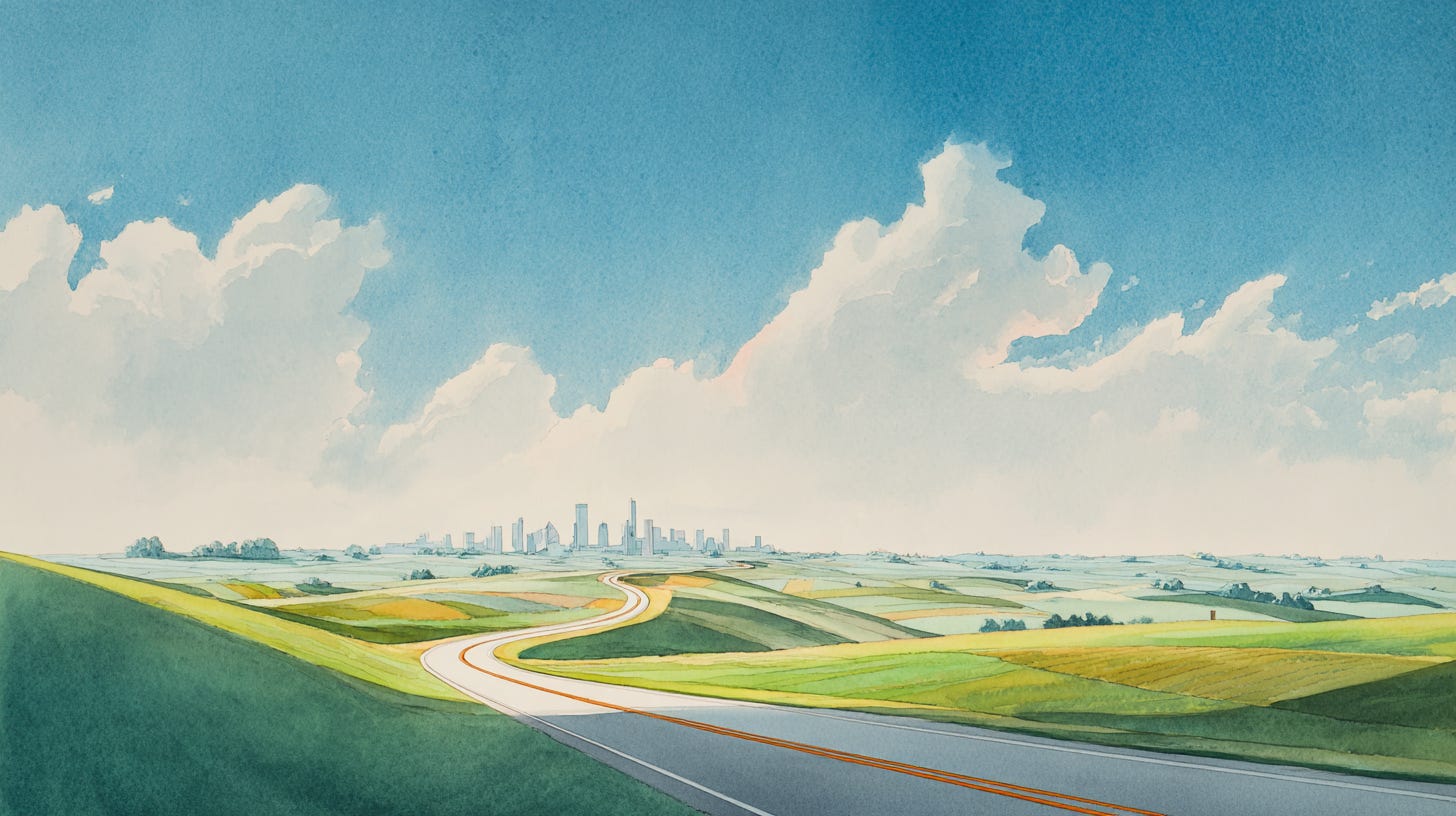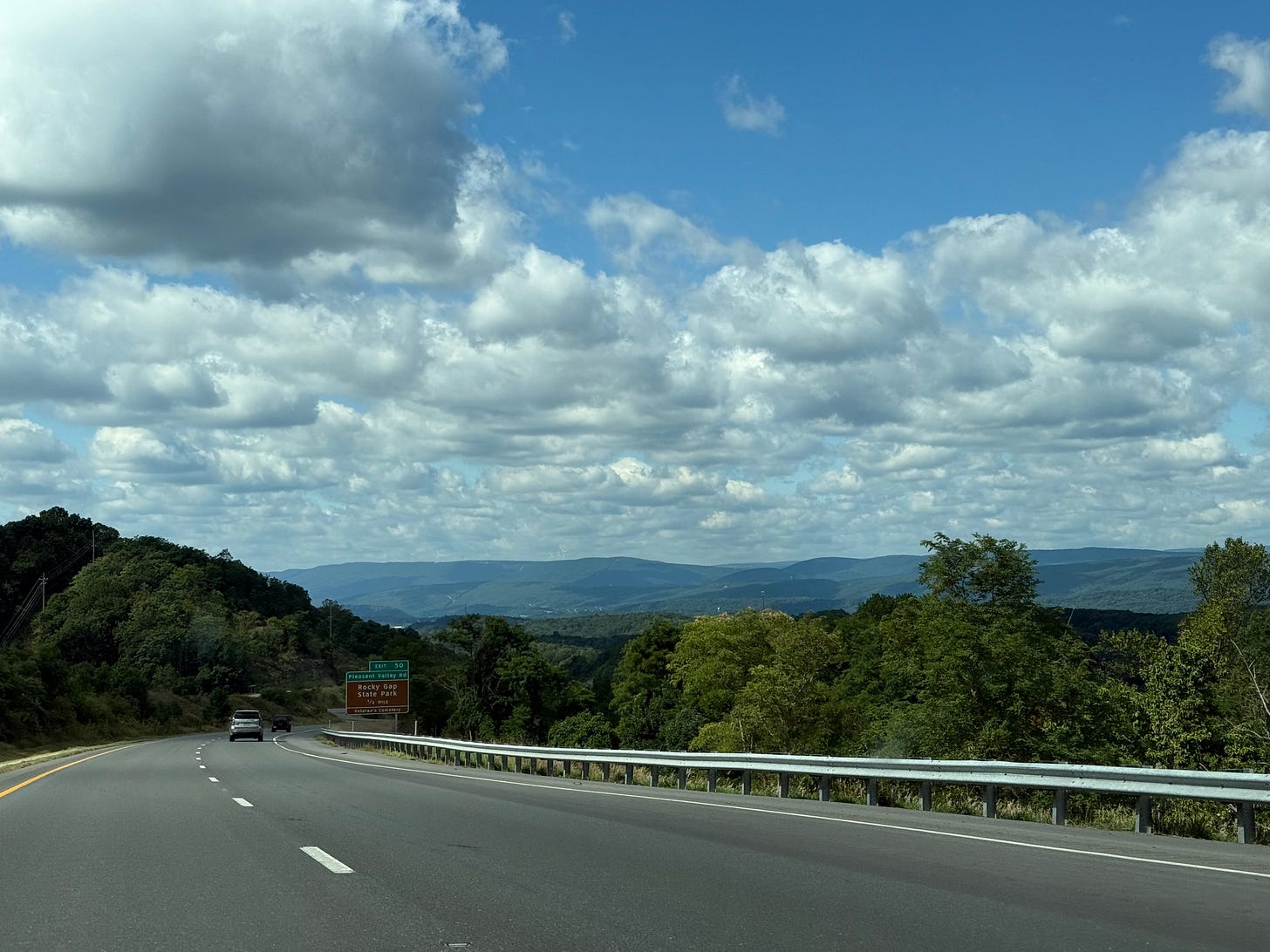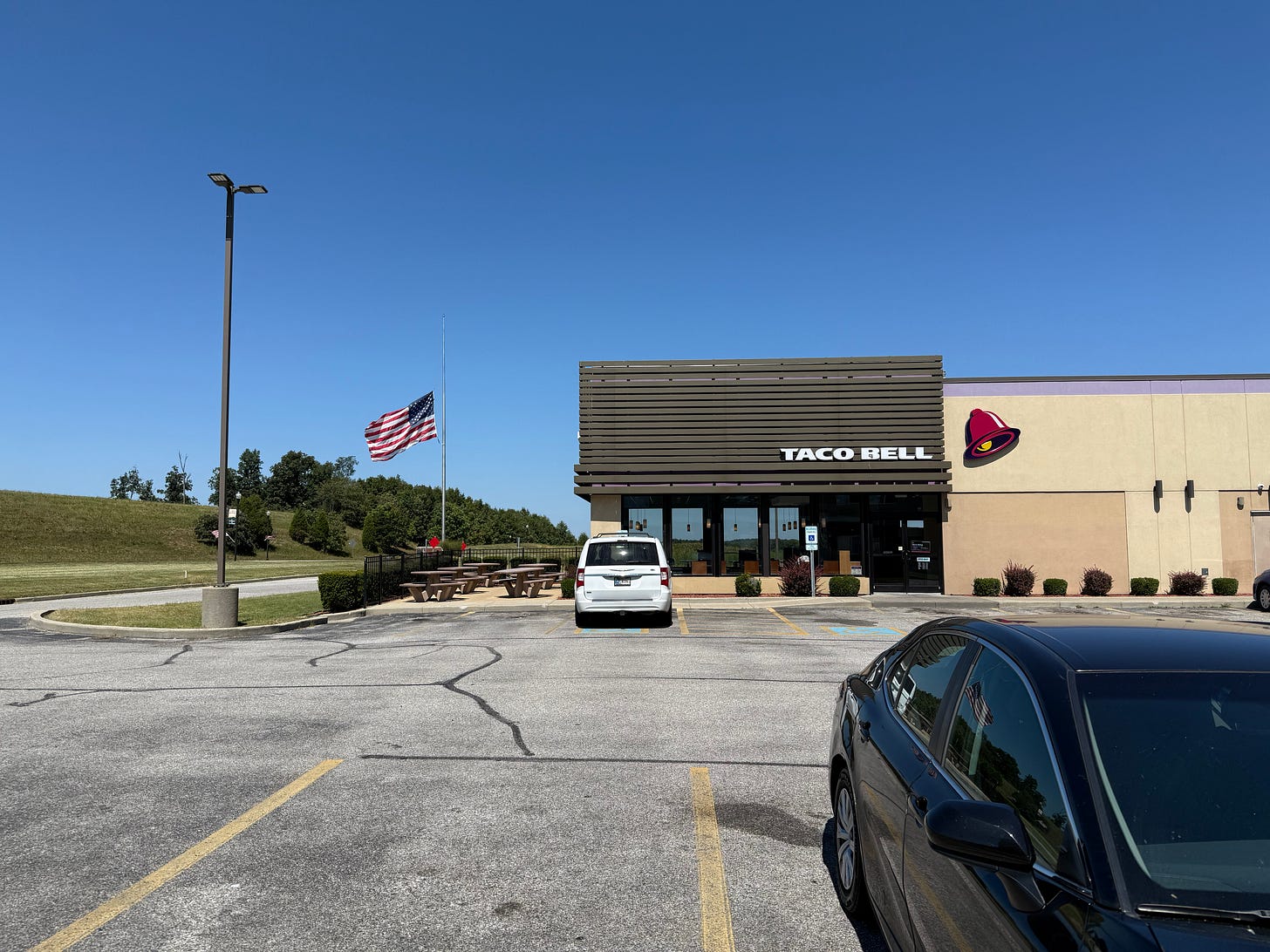Interstate Love Song
Freedom & Oppression on America’s Not-So-Open Roads
On August 1st, my husband and I piled into the car with our Boston Terrier, a veteran road warrior herself, and geared up for the long drive to the East Coast. We spent the whole month away from Austin, trying to beat the hellish Texas heat while spending time with family and friends back home. The journey was largely functional, enabled by America’s vast Interstate Highway System. We were trying to get through places, as safely and quickly as possible, to our various longer-stay destinations in Myrtle Beach, Cape Cod, New York City, and Northern Maryland. It was a trip of contrasts: long daytime drives through remote rural areas broken by overnight stops in big cities. In all, we drove 4,875 miles and passed through twenty-four states.
I’m not sure I’ll do it again.
This wasn’t a road trip in the classic sense—the journey was definitely not the point. Having the dog along meant we couldn’t detour off the highways, so I only got glimpses of the historic—and very urban—downtowns of places like Cumberland, Maryland; Wheeling, West Virginia; and Galena, Kansas. Billboards hinted at off-road diversions we would not take, so I still don’t know why the Uranus Fudge Factory was voted Missouri’s #2 attraction or whether Meramec Caverns really is the “Greatest Show Under the Earth.”
On the other hand, such a trip unlocks whole realms of the country we wouldn’t otherwise see. We visited cities like Cincinnati, St. Louis, and Oklahoma City for the first time. The Interstate revealed beautiful views of the Appalachians of western Maryland and the Hoosier National Forest in southwestern Indiana. On those rural ribbons of road—two lanes each way, a grassy median, farmland or forest on either side—you could almost enjoy the ride, especially when nobody else was around for miles. As America blurred past the windows, we played a soundtrack that enlivened what we saw outside. Driving across Lake Pontchartrain through Slidell, we sang along to Lucinda Williams’s “Joy.” Crossing the Mississippi into St. Louis, we finished listening to Huck Finn as the sun glinted off America’s original aquatic superhighway.
The trip was a potent reminder of the vastness of our country. We crossed the borders of 38% of the land mass of the continental United States, where some 58% of all Americans live, witnessing the topography, climate, and flora change as we cinched the Corn Belt and the Rust Belt and undulated across the High Plains and the Deep South.
But if that was the best on offer, urban highways showed us the worst.
Eisenhower saw the Interstate as a nation-building project, and in one sense he was right—but that vision came at the expense of the cities it was meant to serve. If there is freedom on the open road cutting through America’s wide open spaces, there is only oppression where the road muscles its way into America’s cities. The speed that annihilates distance between cities collapses into gridlock inside them.
Of the cities we stayed in or passed through, from New Orleans to New York City, almost all were scarred by the construction of the urban portions of the Interstate Highway System. Historic, low-income, and racially diverse neighborhoods were bulldozed, downtowns were cut off from their waterfronts, communities were cleaved in two. Downtown America became the Inner City, a place to be avoided at best, or if needs must, to be passed through—all so that commuters who had forsaken the city might more easily get to and from their suburban idylls.
Of course, the commutes are not easy, and the commuters are not kind.
On the road, life is mediated by our vehicles: there are no drivers—only cars, trucks, RVs, tractor-trailers. Occasionally, a bumper sticker offers a glimpse of the occupant’s character: the Tesla with the “I bought this before Elon went crazy” decal, the pickup with the “Trump/Pence” sticker but not the “Trump/Vance” one. You don’t really see that many “Coexist” bumper stickers anymore, perhaps an indication that we’ve given up trying to. Driving on the highway, we all coexist in a state of anonymous anomie.
It shows in the way people drive.
On YouTube there’s a whole category of Russian dashcam videos showing drivers with zero reverence for human life. Watching the way people behave on our own highways, I couldn’t help but think: we’re not so different. From Houston, Texas to Houston Street in New York, blinkers are optional, speeding is mandatory, tailgating is standard, and slowing down in low-visibility conditions is unnecessary. We saw the results daily in car crashes, despite all the signs posted by state highway departments to “DRIVE SAFELY.”
The 40,000 annual deaths on America’s roads are not a national emergency—crashes are just part of the scenery.
And yet, for all that carnage, what’s most striking about the Interstate isn’t its danger but its sameness. It’s a transect of American life by asphalt, lined mile after mile with the same pylon signs sporting the logos of McDonald’s, Taco Bell, Starbucks, and Cracker Barrel’s undead old-timer. A McCrispy chicken sandwich tastes the same in every McDonald’s parking lot; a Crunchwrap Supreme is not improved by the view of cornfields through a Taco Bell window. Starbucks, at least, has made an effort to provide al fresco seating at many of its roadside cafés, giving travelers a sense of what it might be like to sip a Frappuccino on the Boulevard des Capucines. Lest we think all this is an instance of American exceptionalism, there’s a McDonald’s and a Burger King along the autoroute from Charles de Gaulle to Paris, too.
If the fast food at every interchange is interchangeable, the gas stations at least offer some regional flavor: Phillips 66 in the Heartland, Love’s in the Southeast, Buc-ee’s in Texas but metastasizing rapidly elsewhere. I am not, as it were, a “Beaver Believer.” Stepping into Buc-ee’s gives me the same feeling I had when attending a NASCAR race at the Fontana Speedway some years ago—I, overdressed in a Polo shirt, was not among my people.
And yet, these are my people, my fellow Americans, and they were all delighted to be amidst the Beaver-branded emporium, this “happy, Texas version of Grand Central Station.” Undoubtedly, it has the cleanest and most comfortable bathrooms on the road, but I also visited the real Grand Central Station during my trip, and of the two, I would hands-down choose to transit via Grand Central every time, even if its bathrooms are disgusting.
The contrast is instructive. Buc-ee’s is suburbia incarnate: clean, functional, reliable, scaled for mass consumption—but mediocre in every other way. Nobody goes to Buc-ee’s for transcendence; they go for spotless bathrooms and convenience, and Buc-ee’s delivers it in awe-inspiring fashion. Grand Central is the opposite: soaring architecture, civic grandeur, a place that makes you feel part of the thrum of urban life—and yet, the bathrooms double as homeless shelters. It’s a metaphor for the American city: magnificent in form, but too often failing in function.
We’ve settled for mediocrity at scale, not only on the road but in the heart of our cities.
There are always those who will insist this is just capitalism run amok. But Buc-ee’s pays some of the best wages in the industry and clearly outcompetes on service and amenities. What we’re living with isn’t capitalism left to its own devices—it’s capitalism filtered through a century of government policy that mandated car culture. We carved it into the bedrock of our nation via federally-funded interstates to reach suburbs built with federally-subsidized mortgages, bypassing the vital places where small-scale, wholesome American life used to thrive. The roadside monoculture isn’t the invisible hand—it’s the heavy hand of policy.
None of this is to say the Interstate is without benefits beyond its bucolic vistas. It connected far-flung regions, allowed goods to move faster, and opened up new possibilities for travel and commerce. Those gains were real, and they mattered. But what its boosters rarely admit is the other side of the ledger: the destruction of downtowns in our small towns and big cities, the collapse of private freight and passenger rail, the hollowing out of place after place. Indeed, what it left—this monotony of chain restaurants and gas stations along every stroad that crosses the highway—is what replaced Main Street in small-town America. I wonder if all of those neo-traditionalists who today pine for some imaginary 1950s past…do they know that it doesn’t look like an interstate highway, a gas station on steroids, or a Cracker Barrel (founded in 1969)?
They should know: we are never going back. But, where are we going? The Interstate points inexorably in one direction.
For those of us trying to build better places out of this American carnage, it’s worth taking the roads most traveled in America not only to see how the other four-fifths live but to remind ourselves that this is the default experience of American life. Car culture is American culture, long paved into the asphalt over which we unthinkingly drive each day. Whether or not it was inevitable, it has become essential to American life, because we have chosen to make alternatives near-impossible.
If we wish to build safer, healthier, more connected communities, ones where life is not filtered through the false security of our car cabins, well, there are no easy fixes to that. That will require a culture change.
It’s possible, doable even—but from the vantage point of where we are today, man, is it a long road ahead.







ok that fudge factory is not the 2nd best thing to see in Missouri... I grew up there, and it isn't the most tourist friendly place, but come on. The Arch, the Capitol building, the Lake of the Ozarks, and the museum for Scott Joplin and ragtime music would all trump the fudge factory :)
Thanks for sharing yor perspective on the American highway. You're right, it IS and will be a cultural shift to get people to even imagine a world where cars are not the priority but we're getting there, slowly but surely.
This past Tuesday, I attended a lecture given by the President of the ACLU, Deborah N. Archer, where she read from her new book "Dividing Lines" which talks about racism in transportation. Check it out.
Cheers!